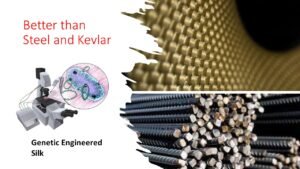Engineers at Washington University in St. Louis have designed amyloid silk hybrid proteins and produced them in engineered bacteria. The resulting fibers are stronger and tougher than some natural spider silks. Researchers used bacteria genetically engineered in the lab of Fuzhong Zhang, a professor in the Department of Energy, Environmental & Chemical Engineering in the McKelvey School of Engineering.
In the artificial silk—dubbed “polymeric amyloid” fiber, the team modified the amino acid sequence of spider silk proteins to introduce new properties while keeping some of the attractive features of spider silk. A problem associated with recombinant spider silk fiber, without significant modification from natural spider silk sequence, is the need to create β-nanocrystals, the main component of natural spider silk, contributing to its strength.
Zhang said, “Spiders have figured out how to spin fibers with a desirable amount of nanocrystals. However, when humans use artificial spinning processes, the amount of nanocrystals in a synthetic silk fiber is often lower than its natural counterpart.”
 To solve this problem, the team redesigned the silk sequence by introducing amyloid sequences that have a high tendency to form β-nanocrystals. They created different polymeric amyloid proteins using three well-studied amyloid sequences as representatives. The resulting proteins had less repetitive amino acid sequences than spider silk, making them easier to be produced by engineered bacteria. Ultimately, the bacteria produced a hybrid polymeric amyloid protein with 128 repeating units. Recombinant expression of spider silk protein with similar repeating units has proven to be complicated.
To solve this problem, the team redesigned the silk sequence by introducing amyloid sequences that have a high tendency to form β-nanocrystals. They created different polymeric amyloid proteins using three well-studied amyloid sequences as representatives. The resulting proteins had less repetitive amino acid sequences than spider silk, making them easier to be produced by engineered bacteria. Ultimately, the bacteria produced a hybrid polymeric amyloid protein with 128 repeating units. Recombinant expression of spider silk protein with similar repeating units has proven to be complicated.
The longer the protein, the stronger and tougher the resulting fiber. The 128-repeat proteins resulted in fiber with gigapascal strength (a measure of how much force is needed to break a fiber of fixed diameter), which is stronger than standard steel. The fibers’ toughness (a measure of how much energy is needed to break a fiber) is higher than Kevlar and all previous recombinant silk fibers. Its strength and toughness are even higher than some reported natural spider silk fibers.



